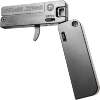I understand your apprehension but in my 55+ years of shooting reliability will always be an issue even with centerfire ammo and handguns. It all boils down to how well one maintains their firearms also and when it comes to say for example 22 long rifle rounds, what does makes a difference, is buying prime ammunition like Lapua, eley and so on ammo more reliable than Yellowjackets . Furthermore the 22 magnum is no slouch, it does travel at rifle speeds of a 22lr round when shot from a pistol.I would disagree on reliability, assuming only factory ammo in either case. With factory ammo, I would choose a center-fire every time, over a rim fire. Rimfires just have a higher failure rate than center-fire cartridges, which cannot be overcome by the design of the firearm. For that reason, I would never choose a rimfire firearm as a first choice as a defensive firearm.
But, of course, if that was all I had, then obviously I would pick that over a baseball bat.
One always hears that they want something bigger than a 22 for making bigger wounds but let me remind you that in 2009 13 people died in Ft Hood when Hasan used a 5.7 FN pistol using small bullets too.
I know I won't convince you and am not trying but sometimes we all don't know everything and what we know is just perception.
Last edited:


